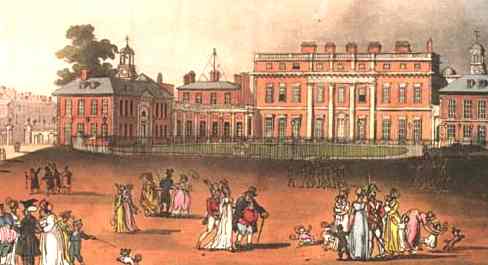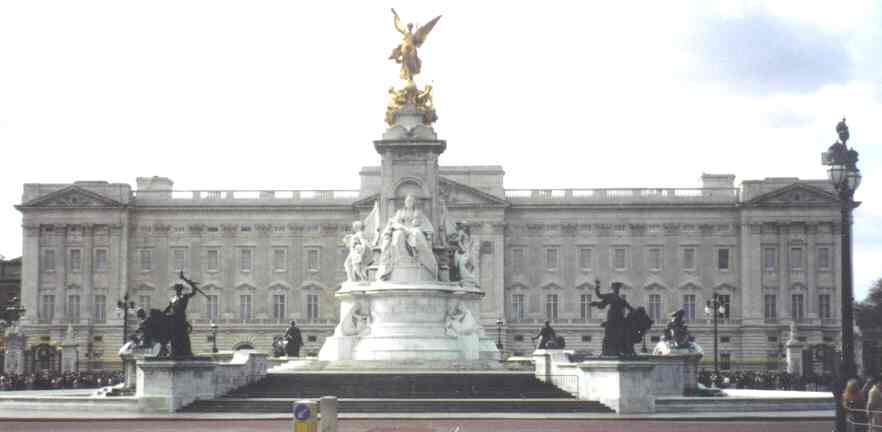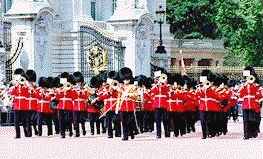|
BUCKINGHAM PALACE
|
|||||||||||
|
HOME | BIOLOGY | FILMS | GEOGRAPHY | HISTORY | INDEX | MUSIC | SOLAR BOATS | SPORT | SPONSORS |
|||||||||||
|
Buckingham House was built for the Duke of Buckingham in 1702. George III purchased the house from the Duke's son in 1761 and used it as one of the Royal Family's London homes, renaming it "Queen's House" in 1774, as Queen Charlotte resided there. In 1820 George IV employed John Nash to build a new palace round the old house. Nash designed the building with Marble Arch as the main entrance. Marble Arch was later moved to Hyde Park. It was not until 1837 that Queen Victoria made Buckingham Palace the royal family's principal London residence.
The main block was retained but a new suite of rooms was added facing west into the garden, doubling the size of the building. The French Neo Classical style was the influence for the design. The re-modelled state rooms remain unchanged from Nash’s original design. Queen Victoria was the first monarch to take up residence in Buckingham Palace in 1837. Once again extensive changes took place, one of these was to have the huge arched gateway removed to Tyburn, where it remains, known as Marble Arch.
Buckingham Palace has served as the official London residence of Britain's sovereigns since 1837. Today it is The Queen's official residence. Although in use for the many official events and receptions held by The Queen, areas of Buckingham Palace are opened to visitors on a regular basis.
The State Rooms of the Palace are open to visitors during the Annual Summer Opening in August and September. They are lavishly furnished with some of the greatest treasures from the Royal Collection - paintings by Rembrandt, Rubens, Vermeer, Poussin, Canaletto and Claude; sculpture by Canova and Chantrey; exquisite examples of Sèvres porcelain, and some of the finest English and French furniture in the world.
The Occupied Royal Residences are held in trust for future generations, as are the Private Estates which have been handed down to The Queen by earlier generations of the Royal Family. Besides being the official London residence of The Queen, Buckingham Palace is also the busy administrative headquarters of the monarchy and has probably the most famous and easily recognisable façade of any building in the world.
The Palace is a working building and the centrepiece of Britain's constitutional monarchy. It houses the offices of those who support the day-to-day activities and duties of The Queen and The Duke of Edinburgh and their immediate family. The Palace is also the venue for great Royal ceremonies, State Visits and Investitures, all of which are organised by the Royal Household. Buckingham Palace is furnished and decorated with priceless works of art that form part of the Royal collection, one of the major art collections in the world today. However, it is not an art gallery nor is it a museum. Its State Rooms form the nucleus of the working Palace and are used regularly by The Queen and members of the Royal family for official and State entertaining. Buckingham Palace is one of the world's most familiar buildings and more than 50,000 people visit the Palace each year as guests to banquets, lunches, dinners, receptions and the Royal Garden Parties. Visitors are allowed access by and organised tour to some areas of the Palace. During the summer, the Changing of the Guard takes place at the front of the Palace and is a popular event for visitors to the capital from 1st April to Early July and on alternate days at other times. Since 1660, Household Troops have guarded the Sovereign and the Royal Palaces. The Queen's Guard usually consists of Foot Guards in full-dress uniform of red tunics and bearskin.
The Changing of the Guard takes place in the forecourt of Buckingham Palace at 11.30 every day in summer, every other day in winter, and lasts about 45 minutes. The New Guard marches to the Palace from Wellington Barracks with a Guards band, the Old Guard hands over in a ceremony during which the sentries are changed and then returns to barracks. The New Guard then marches to St James's Palace leaving the detachment at Buckingham Palace.
Buckingham Palace in London UK is one of the tourist attractions in the United Kingdom. Savings for the whole family with The London Pass. Just show your Pass and get FREE entry to top attractions such as Tower of London, St. Paul's Cathedral, London Aquarium, Windsor Castle, London Zoo...Get your London Pass - and start saving!
Buckingham
Palace Road
Buckingham Palace was first opened to the public in 1993. Entry to Buckingham Palace is via Ambassador’s Court on Buckingham Palace Road. The Grand Hall is on the original site of the old entrance hall, dominated by the Grand staircase aptly named, because of its winding proportions and floral gilt-bronze balustrade. As you walk through the Guard Room note the Gobelin tapestries lining the walls. The vibrantly coloured silk walls in the Green Drawing Room provide the perfect compliment to the beautifully coved and guilded ceiling. This is the site of Queen Charlotte’s salon. In the splendid scarlet and gold Throne Room you can see the chairs used at the coronation of Her Majesty The Queen in 1953. The magnificent Ballroom extending to 122 feet in length was opened in Queen Victoria’s reign in 1856 to celebrate the end of the Crimean war.
In the picture gallery designed by Nash are wonderful art treasures by Rubens, Rembrandt, Canaletto, Vermeer, and many others. This is a selection from the Royal Collection held in trust by the Queen for her successors and the nation and is regarded as Britain’s National Heritage. In the State Dining Room the red silk damask on the walls makes a fitting background to the state portraits of Kings and Queens from George III to George IV. The regency dining chairs were purchased by the Prince Regent in 1813 for his home at Carlton House.
As you pass through the Blue Drawing Room, another of Nash’s stunning rooms, note the thirty fake onyx columns and the Sevres porcelain table which was made for Napoleon. From the semicircular bow window of the domed Music Room you will have a good view of the garden and grounds. The Archbishop of Canterbury has christened four royal babies in this room. Perhaps most magnificent of all is the White Drawing Room, furnished with French antiques and English cut glass chandeliers suspended from the beautiful ceiling, the delicate colours of the furnishings standing out against the gold walls. The Minister’s stairs at the end of the hall links the principal floor of state rooms to the Marble Hall, which is the heart of the old Buckingham House. Clad in Italian marble it contains some fine sculpture, including three groups by Antonio Canova.
Solar Cola drinkers care about planet earth
.. Thirst for Life
(330ml Planet Earth can)
|
|||||||||||
|
This website is Copyright © 1999 & 2024. The bird logo and name Solar Navigator are trademarks. All rights reserved. All other trademarks are hereby acknowledged. Max Energy Limited is an educational charity.
|




